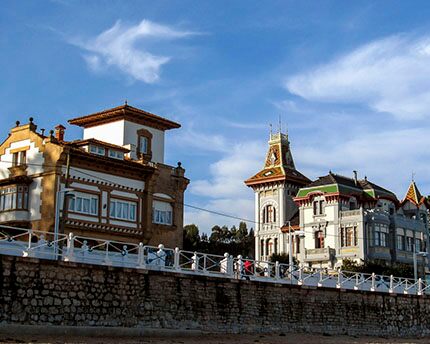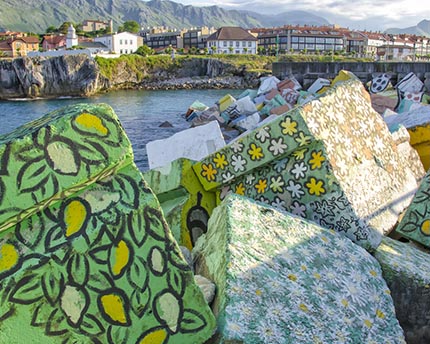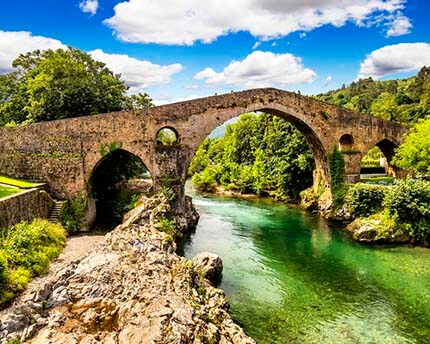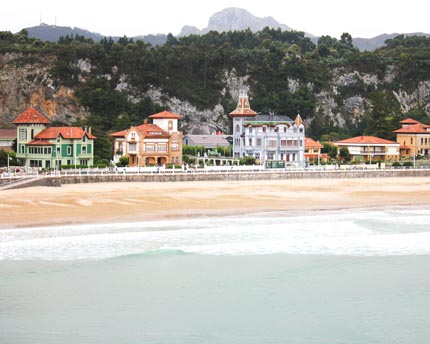Eastern Asturias
The eastern end of Asturias, which broadly speaking spans from San Vicente de la Barquera to Ribadesella, attracts more visitors each year than its western neighbour. The crowning glory of Asturias’ eastern region are the Picos de Europa.
These eastern lands can claim to have witnessed the beginning of the Christian reconquest of Spain in the early 8th century. There is an enticing history here that enriches the area, creating links between coastal and inland communities against an overwhelmingly beautiful natural backdrop.
The 60 kilometres of coastline are characteristic of Asturias — karst landscapes, powerful waves and lush vegetation that grows defiantly in a place battered by the elements. Visit the stretch taking in Ribadedeva, Llanes and Ribadesella to witness a natural blowhole phenomenon whereby jets of water spray out of cracks in the rocks when the sea really gets up.
Eastern Asturias has beaches and an abundance of natural and cultural attractions. Pimiango, in the Ribadedeva district, boasts the 600-m deep prehistoric Pindal Cave, of which 300 metres are accessible. The old town in Llanes is filled with Medieval relics including 13th-century walls and turrets, along with examples of indiano architecture from the early 20th century (an indiano was a someone who emigrated to the Americas and who returned to Europe wealthy). Another coastal town, Ribadesella, is famous for hosting the annual canoe race down the Sella River. Participants start in Arriondas and travel 20 km downstream before reaching the Cantabrian Sea.
Moving inland, Cangas de Onís and Arenas de Cabrales are just two of the area’s pretty destinations and both are part of the Picos de Europa National Park. The town of Cangas de Onís was founded more than a thousand years ago and in days gone by was the first capital of the Kingdom of Asturias. The famous ‘Roman bridge’ at the entrance to the town was actually built during the Medieval period. Hanging proudly from the bridge is a replica of the Victory Cross that Pelagius of Asturias, the first monarch of the Kingdom of Asturias, carried in the legendary Battle of Covadonga.
Years later, the sanctuary of Covadonga was built on the very site of this famous stand against the Islamic troops. Nestled inside the same cave which, legend has it, provided refuge for Pelagius’ men, the sanctuary has become a symbol of Asturias and is a popular tourist site. From a distance, a waterfall appears to flow from inside the chapel itself; it captures your attention, luring you inside. Within is a statue of the Virgin and the tomb of Pelagius himself.
Lastly, the Picos de Europa are the perfect destination for hiking enthusiasts. The range is home to the highest peak in Asturias and in the Cantabrian Mountains. There are several hiking options including the famous 24-km Cares Trail, where the contrast between the depth of the valley and the height of Pico Uriellu (or Naranjo de Bulnes) really throws the grandeur of the landscape into sharp relief.
Nearby plans
Related plans

Qué ver en Ribadesella: deporte, cultura, ocio y gastronomía
Deportes, como el Descenso Internacional del Sella, cultura, tradición, playas y visitas arqueológicas en la cueva de Tito Bustillo. ¡Descubre qué ver en Ribadesella!

Descubre qué ver en Llanes, destino predilecto de la costa asturiana
Llanes muestra su riqueza cultural y natural en cada de sus rincones. Pronto comprenderás por qué está considerado como uno de los más bellos de Asturias.

Canga de Onís, naturaleza, gastronomía e historia
Puerta de entrada a los Picos de Europa, Cangas de Onís es arte, historia y buen comer en un entorno natural privilegiado. Déjate seducir por su casco histórico.


